Images in Navarra of the III Centenary of the canonization of Xavier (I)
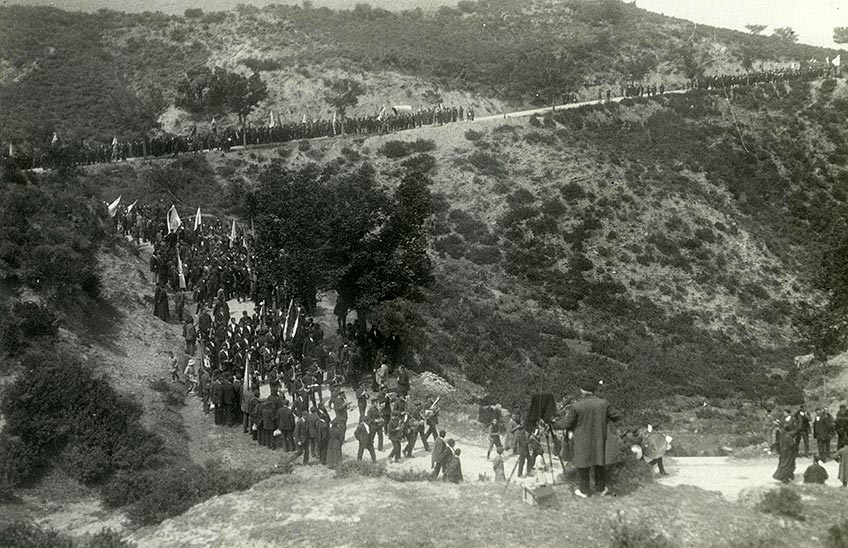
PhotoRoldán. file General de Navarra/Arrival of the pilgrims at Javier on 15 May 1922.
If the celebrations of the 3rd Centenary of the canonisation of St Francis Xavier in Navarre stood out for anything, it was for their extension throughout the whole of Navarre, from the spring to the autumn of 1922.
The information on all this is provided by the extensive, beautifully edited and bound programme, the monograph by Goñi Gaztambide in volume XI on the bishops of Pamplona, the magazine La Avalancha, the regional newspapers and, above all, the book-chronicle on the journey of the relics of Saint Ignatius and Saint Francis Xavier, published in 1924 by Father Constancio Eguía, with a large graphic apparatus. In this last publication, a total of 165 pages give a precise account of how those commemorations, framed in the Jubilee Year granted by Benedict XV, were celebrated and lived.
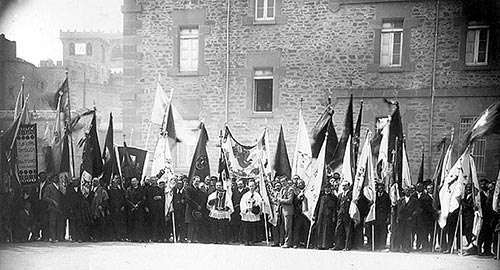
Representatives of the Cajas Rurales de Navarra with their flags on the pilgrimage to Javier on 15 May 1922. Photo Roldán. file General of Navarre
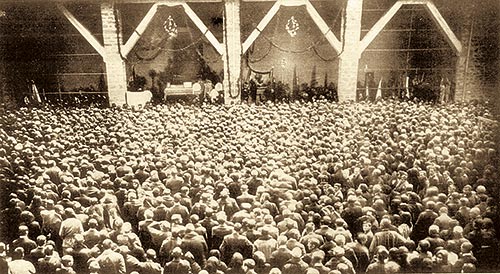
Mass in one of Javier's gables on 15 May 1922. Private collection
The great pilgrimage of the agricultural cooperative movement in May
On 15 May, a large rally took place in Javier, sponsored by the Cajas Rurales Navarras, attended by 7,000 farmers and ninety flags. The mass, the lunches and the journeys, both on foot and in vehicles of all kinds subject, were very well attended.
As is well known, the Church's social action played a very important role in the creation of the Cajas Rurales, in a context in which formulas were sought to provide farmers with cheaper money in the form of affordable loans. In Navarre, the leaders of the movement were the propagandists and priests Victoriano Flamarique and Antonio Yoldi, under the episcopate of Fray José López y Mendoza. The founding development was so rapid that Navarre, between 1907 and 1912, became an example for the rest of Spain. The two aforementioned priests had attended a course in Valencia on Catholic agricultural associations, given by Father Antonio Vicent, and they are considered to be among the leading exponents of the organisation of agricultural cooperativism and social propagandism.
From the detailed chronicle of the religious-festive event of May 1922, which appeared in Diario de Navarra, we know that a special train arrived in Sangüesa and from there the pilgrims set off on foot and in vehicles towards Javier "and in the middle of that jumble, although it may seem a paradox, the caravan was reorganised and arrived at its destination..., the registered vehicles stopped at the top of Javier, from where the pilgrims descended on foot, in procession, carrying their flags in the middle of them. That stretch of road resembled an anthill".
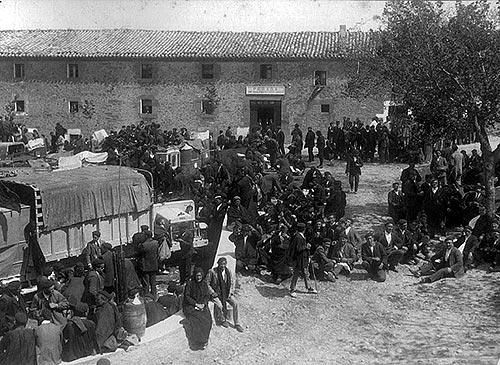
Pilgrims from the Cajas Rurales Navarras in Javier on 15 May 1922. Photo Roldán. file General of Navarre
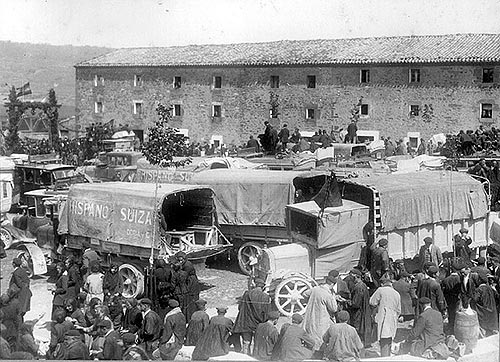
Pilgrimage of the Cajas Rurales to Javier on 15 May 1922. Photo Roldán. file General of Navarre
A large arch richly decorated with foliage welcomed the pilgrims with the legend: "San Francisco Javier blesses the pilgrims". As in Sangüesa, there was no lack of the traditional elements of any fiesta: the ringing of bells, fireworks, music, as well as hangings and pastries. Before the mass, held in one of the frontons, the pilgrims with their flags stood in front of the castle to receive the blessing with the reliquary arm of the co-patron saint of Navarre and the Crucifix of the crab. The bishop of Pamplona was unable to celebrate the mass due to illness. After the religious official document , in which the Orfeón de Puente la Reina took part, conducted by the curate Epifanio Irigoyen, the groups dispersed for lunch. Spectacular photographs taken by Roldán's studio and preserved in the Photo Library of file General de Navarra have survived from this last moment. Afterwards, the relics were venerated in the basilica and the return journey was organised, in the midst of a strong wind and quite cold.
Father Constancio Eguía, in the aforementioned monograph, notes: "They are up to seven thousand; an immense mass of people, all honest and unleavened, who bring the pure intention of being one day, hand in hand with their saint, in his own house. To get there, many of them have had to travel eighty and a hundred kilometres, in private cars, in cars, in trucks, in wagons, in horseback rides. There was even a man from the village of Abárzuza, ninety kilometres away from the castle, who, full of pity and not intimidated by such an enormous distance, came on foot. In the same chronicle, he singled out a couple of highlights: the blessing with the Christ of the crab and the arm of the saint with the kneeling crowd, and the consecration of the mass, noting that "at the raising, all those eighty flags fell before his divine Majesty, while thunderous rockets, launched from the castle's keep, pierced the space. Before the mass began, the Bishop of Jaca blessed the flag of the Federation, embroidered by the Josefinas nuns of Pamplona, and another twenty-five new flags from the same number of Rural Banks".
The written press also reported the negative side of that workshop, with two accidents that claimed two victims, one run over by a vehicle in Artajona and the second under the wheels of the special train at Artieda station.
To find out more
Diario de Navarra, 16 May 1922
EGUÍA RUIZ, C., Reliquias de San Ignacio de Loyola y San Francisco Javier. Su recorrido triunfal por España, Madrid, Blass, S. A. Tipográfica, 1924.
FERNÁNDEZ GRACIA, R., San Francisco Javier Patron Saint of Navarre. Fiesta, religiosidad e iconografía, Pamplona, Government of Navarre, 2006.
FERNÁNDEZ GRACIA, R., "Heritage and identity (62). San Francisco Javier, 1922". Diario de Navarra, 11 March 2022, pp. 58-59.
GOÑI GAZTAMBIDE, J., History of the bishops of Pamplona. XI. Siglo XX, Pamplona, Eunsa, 1999.
